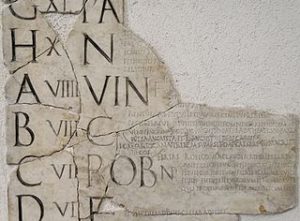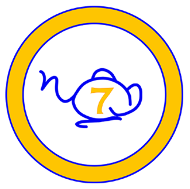Roman Time
 The Roman day, like ours, was divided into twenty four hours – twelve hours of day from sunrise to sunset, and twelve hours of night from sunset to sunrise. This means that days and hours and minutes would be a slightly different length every day as the seasons passed, and the days got shorter or longer. It also means that cities at different latitudes would have different hour lengths on the same day. The night was also broken into four watches (vigilae – from which comes the English “vigil”) of three hours each.
The Roman day, like ours, was divided into twenty four hours – twelve hours of day from sunrise to sunset, and twelve hours of night from sunset to sunrise. This means that days and hours and minutes would be a slightly different length every day as the seasons passed, and the days got shorter or longer. It also means that cities at different latitudes would have different hour lengths on the same day. The night was also broken into four watches (vigilae – from which comes the English “vigil”) of three hours each.
Roman timekeeping devices were pretty basic – sundials and water clocks. It’s a good thing they hadn’t got around to sophisticated clockwork, as the challenge of building a clock which constantly recalibrated itself might have been a bit much. Similarly, it’s just as well they didn’t have instant communication between cities, as the lack of an empire wide time system would have caused some confusion.
Days of the Roman Month
The Romans didn’t number the individual days of their months like we do – they had three special times in each month – the kalends, the nones and the ides of the month, and all other days would be described in terms of these.
- The kalends of a month were the first day of the month
- the nones of a month were either the fifth day of the month if it was a short month, or the seventh day of the month for a long month
- the ides of a month were either the thirteenth day of the month if it was a short month, or the fifteenth day of the month if it was a long month
Individual days were numbered by saying how long it was until the next kalends, nones or ides – even if they fell in the next month. For instance, for the 27th of June, we’d describe the date as being “five days before the kalends of July”, or “ante diem Kal. V Ivlivs”. Actually we would say “four days before the kalends of July”, but the Romans counted inclusively – they would say Monday was five days before Friday, counting “Monday, Tuesday, Wednesday, Thursday, Friday”. The day directly before the kalends, nones, or ides would be called “pridie kalends” or the like, similar to the English “the eve of”.
Earlier versions of the Roman calendar were based on lunar months, and the kalends, nones and ides were determined by the phases of the moon – the kalends on the the new moon, the nones on the quarter moon and the ides on the full moon. Later versions of the calendar discarded lunar months, makes things simpler for us.
Roman Months
 The months of the Roman calendar eventually evolved into the calendar we use today, but they went through a number of complicated changes first.
The months of the Roman calendar eventually evolved into the calendar we use today, but they went through a number of complicated changes first.
First was the Calendar of Romulus, named after one of the two mythical founders of Rome. It had ten months, started in March, and was only 304 days long. The remaining days of the year were not attached to any particular month. You may have noticed that many of our months correspond to numbers (September – septem = 7 in Latin, October – octo = 8 in Latin…) and that those numbers are just plain wrong – September is the ninth month, not the seventh. This is because after the Calendar of Romulus, the Romans had a go at cleaning up the calendar and added a couple of new months onto the start of the year.
This was the Calendar of Numa Pompilius, second king of Rome, and it got rid of the “lost” days which didn’t belong to any month, adding them to two new months, January and February. He also changed the number of days in each month to be an odd number, to avoid the bad luck that came with even numbers. This calendar added up to 355 days, so it still didn’t equal a solar year, and drifted out of synch with the seasons. To control this, extra days were added to the middle of February in some years, a process called “intercalation”. While these were meant to keep the years synchronised with the seasons, but unfortunately the defining of intercalations was a political task, not a scientific one, and the pontifex maximus, in charge of setting intercalations would sometimes lengthen or shorten years to help their friends and hurt their enemies.
 The final reform was the Julian calendar, instituted in 45 BC by Julius Caesar. This added ten more days to the year by adding one or two days to various months. This calendar also got rid of random intercalations by simply adding an extra day to February every fourth year, giving us the concept of the leap year. And because you can do pretty much what you want when you’re an emperor, the fifth month, Quintilus, was renamed Julius (July) in honour of Julius Caesar. Later, in 8 AD, the month Sextilis was renamed Augustus (August), in honour of the emperor Augustus. It’s good to be emperor.
The final reform was the Julian calendar, instituted in 45 BC by Julius Caesar. This added ten more days to the year by adding one or two days to various months. This calendar also got rid of random intercalations by simply adding an extra day to February every fourth year, giving us the concept of the leap year. And because you can do pretty much what you want when you’re an emperor, the fifth month, Quintilus, was renamed Julius (July) in honour of Julius Caesar. Later, in 8 AD, the month Sextilis was renamed Augustus (August), in honour of the emperor Augustus. It’s good to be emperor.
At the time of these reforms, the calendar had become quite out of synchronisation with the seasons, so in 46 BC there was one special year of 455 days to get things lined up properly again.
The Julian calendar is very close to the Gregorian calendar we use today, with the difference that leap years are no longer every fours years, but are occasionally missed, to keep the calendar from drifting.
The Roman Clock app uses the reformed Julian calendar. One might speculate that this is because it is far simpler to do that than to deal with the calendars of Romulus or Numa Pompilius.
Roman Clock and Calendar App
Now that you know about Roman timekeeping and calendars, the next thing you need is an iPhone or Android App which will handle times and dates in both modern and Roman time systems, modern and Roman calendar notations, and in Latin and English. And here it is. Thanks for reading.
